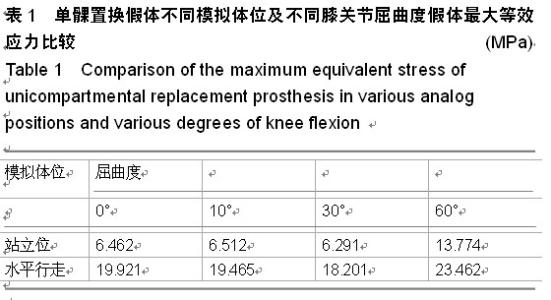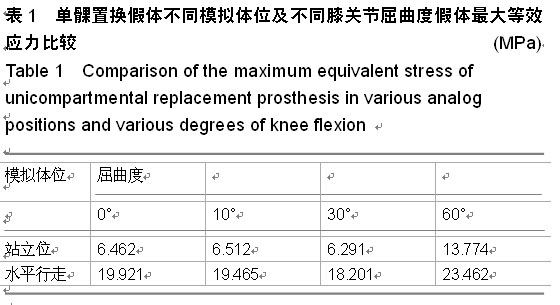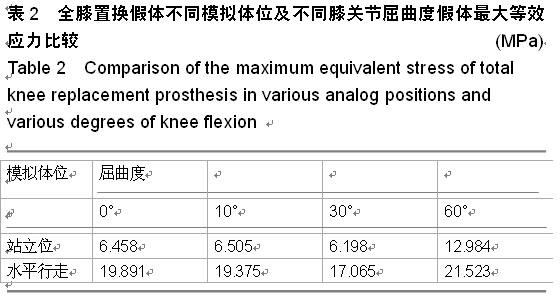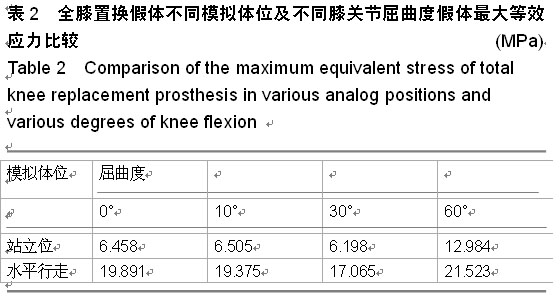| [1] 李宇,许建中,田科.膝关节单髁置换的研究进展[J].中国实用医刊,2012,39(3):109-111.
[2] 涂意辉,马童,薛华明. 第三代牛津单髁系统在膝关节内侧问室骨性关节炎的应用[J].生物骨科材料与临床研究,2013,10(3): 40-42.
[3] Saccomanni B. Unicompartmental knee arthroplasty:a review of literature. Clin Rheumatol.2010;29(4):339-346.
[4] 侯波,王毅,沈宇辉.膝关节动态有限元模型的力学分析[J].中国组织工程研究,2013,17(22).3998-4004.
[5] 周广全,何伟,庞智晖,等.基于参数化联合建模法建立膝关节单髁置换三维有限元模型研究[J].广东医学, 2012, 33(3): 328-330.
[6] 姜华亮,华锦明,许新忠.正常人膝关节三维有限元模型的建立[J]. 苏州大学学报:医学版,2008,28(3):421-422.
[7] 徐志才,胡广洪.胫骨模型对膝关节有限元分析结果影响的探讨[J].中国数字医学,2014,9(4):69-72.
[8] 张冠军,魏嵬.行人膝关节有限元模型的建立与验证[J].汽车工程, 2014,36(9):1068-1073.
[9] 李晓淼,沈奕,王伟力,等.全膝关节假体三维有限元模型建立[J].中国组织工程研究与临床康复,2011,15(13):2304-2308.
[10] 陈镇秋,张秋霞.膝关节单髁置换三维参数化建模[J].中国组织工程研究,2013,17(4):588-593.
[11] 刘志宏,刘利.不同型号配对固定平台型膝关节假体生物力学有限元分析研究[J]. 国际骨科学杂志,2012,33(5):322-325.
[12] 张文. 基于A N SY S研究人体膝关节生物力学模型[D]. 苏州:苏州大学, 2010:11-12.
[13] Pena E, Calvo B, Martínez MA, et al. A three-dimensional finite element analysis of the combined behavior of ligaments and menisci in the healthy human knee joint. J Biomech. 2006;39:1686-1701.
[14] Joshi MG, Advani SG,Miller F,et al.Analysis of a femoral hip prosthesis designed to reduce stress shidding. J Biomech. 2000;33(12):1655-1662.
[15] Satku K.Unicompartmental knee arthroplasty:is it a step in the right direction.Surgical options for osteoarthritis of the knee. Singapore Med J. 2003;4(11):54-56.
[16] 张启栋.刘朝晖.人工膝关节单髁关节置换术研究进展[J].中国矫形外科杂志,2009,17(17):1319-1321.
[17] Choy WS, Kim KJ, Lee SK, et al. Mid-term results of oxford medialunicompartmental knee arthroplasty. Clin Orthop Surg. 2011;3(3):178-183.
[18] Munk S,Dalsgaard J, Bjerggaard K, et al. Early recovery afterfast-track.Oxfordunicompartmental knee arthroplasty:35 patients with minimalinvasive surgery. Acta Orthop. 2012; 83(1): 41-45.
[19] 胡懿郃,王贤,廖前德,等.单髁膝关节置换治疗膝关节单间室病变[J].中国矫形外科杂志, 2008, 16(3): 161-163.
[20] Heyse TJ, Khefacha A, Cartier P. UKA in combination with PFR at average 12-year follow-up. Arch Orthop Trauma Surg. 2010; 130:1227-1230.
[21] 刘志宏,何川,冯建民,等.单髁膝关节置换术后膝关节三维运动学特性研究[J].中华关节外科杂志(电子版),2013,7(4):4-7.
[22] Pietschmann MF, Wohlleb L, Weber P, et al.Sports activities after medial unicompartmental knee arthroplasty Oxford III-What can we expect? Int Orthop. 2012;(37):31-37.
[23] Kim YH,Kim JS,Choe JW, et al. Long term comparison of fixed-bearing and mobile-bearing total knee replacements in patients younger than fifty-one years of age with osteoarthritis. J Bone Joint Surg. 2012;94(10):866-873.
[24] McEwen HM, Barnett PI, Bell CJ, et al. The influence of design, materials and kinematics on the in vitro wear of total knee replacements. J Biomech.2005;38(2):357-365.
[25] Saenz CL, Mcgrath MS, Marker DR, et al. Early failure of a unicompartmental knee arthroplasty design with an allpolyethylene tibial component. Knee. 2010;1:53-56.
[26] 张启栋.单髁关节置换术失败原因分析[J].中国矫形外科杂志, 2010,18(11): 912-915.
[27] Stoller AP, Johnson TS, Popoola OO, et al. Highly crosslinked polyethylene in posterior-stabilized total knee arthroplasty:in vitro performance evaluation of wear, delamination,and tibial post durability. J Arthroplasty. 2011;26(3):483-491.
[28] 李宝文.全膝人工关节置换涉及的生物力学变化[J].中国组织工程研究与临床康复,2008,12(17):3313-3316.
[29] Sawatari T, Tsumura H, Iesaka K, et al. Three-dimensional finite element analysis of unicompartmental knee arthroplasty-the influence of tibial component inclination. J Orthop Res. 2005;23:549-554.
[30] 赵艳,王禹.人工膝关节的生物摩擦学特点[J].中国组织工程与临床康复,2010,14(22):4090-4092.
[31] 马妮,肖丽英.基于LifeMOD的个性化人工膝关节设计中的生物力学分析[J].康复医学工程,2011, 26(6):6538-6542.
中国组织工程研究杂志出版内容重点:人工关节;骨植入物;脊柱;骨折;内固定;数字化骨科;组织工程
|



